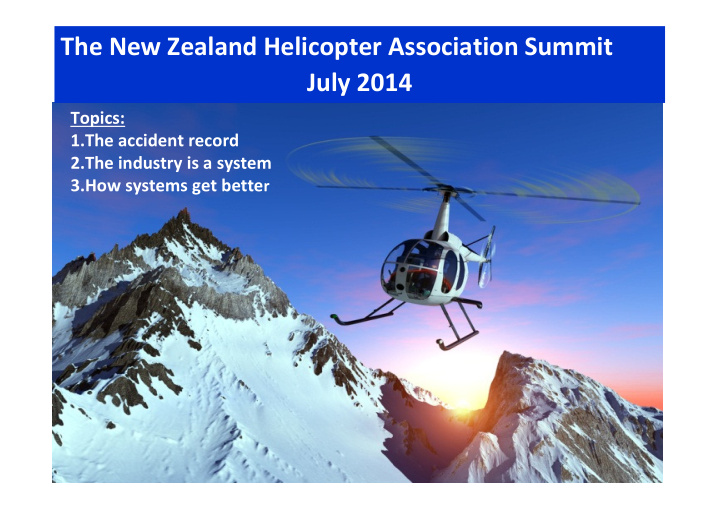



The New Zealand Helicopter Association Summit July 2014 Topics: 1.The accident record 2.The industry is a system 3.How systems get bette r
Our safety record since the Seventies: 1154 accidents, 1970 – 2014.
188 fatalities, 97 pilots and crew, 89 passengers. Average 4 people killed per year.
346 machines destroyed or written-off; 228 piston and 118 turbine.
On those destroyed machines… Estimate of current market prices for second hand helicopters: Piston $225,800 Turbine $848,750 $ 156, 194, 900 total That total doesn’t include: Repairs for damaged machines Social costs of deaths and injuries Legal fees Lost work hours Reduced productive capacity
IMPORTANT: the trend over time: We have improved over time.. But since 2000 we have hit a plateau.
The NZ Helicopter Industry: a system 137 commercial operators 512 helicopters owned 47% own two or fewer machines 124 currently active ATPL holders 1237 currently active CPL holders
How do systems get better? “We need a mechanism by which the system regenerates itself continuously by using, rather than suffering from, random events, unpredictable shocks, stressors and volatility.” “A system that overcompensates is necessarily in overshooting mode, building extra capacity and strength in anticipation of a worse outcome and in response to information about the possibility of a hazard .” Quotes from N. N. Taleb – ‘Antifragile’ , 2012. Penguin Books. P. 8 and P. 45.
Information and analysis to improve operations: the challenge we are facing Generally the best operations are also Small operations the most ‘plugged in’ to information about safety risks and the industry itself. Without information about hazards, threats and strategies, there can be no real improvements to the full system .
We need to distribute the information we have throughout the whole system – we need to draw in all operators. This proposal is Small operations that the NZHA collaborates with CAA information unit to develop a regular series of occurrence and safety updates (‘Bulletins) that we distribute. The goal is to develop greater sense of ‘one industry’ and to share information and strategies to reduce the accident rate.
Inventory: what information do we have? A lot: with 1154 total accidents, we have had every type of accident that we can have . Below are the top ten primary causes of all accidents since 2000: Mechanical Mechanical Unrealistic expectation of power Unrealistic expectation of power available available Mishandled Mishandled CFIT CFIT Wire Strike Wire Strike Runaway helicopter Runaway helicopter Operating in inappropriate conditions Operating in inappropriate conditions Loss of control Loss of control Inadequate training of ground crew Inadequate training of ground crew Overloaded for conditions Overloaded for conditions
The proposed process: Operational safety knowledge: our database Safety Information information is completely submitted to de-identified CAA Concise reports (‘bulletins’) distributed to Causes assigned all operators by NZHA committee; resilience techniques and strategies proposed.
De-identifying information and Structure of safety bulletins we reports: can produce: a) Synopsis of the type of safety Means the removal of: issue (e.g. CFIT accidents) a)All individuals’ names and; b) Summary of major b)All business and company international research, if it is available names and; c) Statistical analysis of the c)All aircraft identification issue – major trends and risk information and; factors (e.g. CFIT the main type of accident for d)All location information commercial transport ops.) where this would likely reveal d) Brief descriptions of ‘classic an identity. examples’ of the type of Guiding principle: Any accident or incident e) Steps that all operators piece of information that can can/should take to reduce or possibly identify any aviation eliminate the chance that the system participant will be type of accident or incident removed. will threaten their operation.
And for a final point, consider this:
It’s the safer operators who get the better jobs
Recommend
More recommend